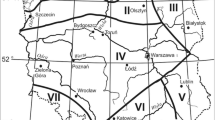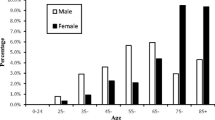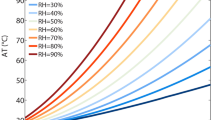Abstract
This paper presents a study to develop a heat index, for use in hot and humid sub-tropical climate in Hong Kong. The study made use of hospitalization data and heat stress measurement data in Hong Kong from 2007 to 2011. The heat index, which is called Hong Kong Heat Index (HKHI), is calculated from the natural wet bulb temperature, the globe temperature, and the dry bulb temperature together with a set of coefficients applicable to the high humidity condition in the summer of Hong Kong. Analysis of the response of hospitalization rate to variation in HKHI and two other heat indices, namely Wet Bulb Globe Temperature (WBGT) and Net Effective Temperature (NET), revealed that HKHI performed generally better than WBGT and NET in reflecting the heat stress impact on excess hospitalization ratio in Hong Kong. Based on the study results, two reference criteria of HKHI were identified to establish a two-tier approach for the enhancement of the heat stress information service in Hong Kong.







Similar content being viewed by others
References
Beniston M, Diaz HF (2004) The 2003 heat wave as an example of summers in a greenhouse climate? Observations and climate model simulations. Glob Planet Chang 44:73–81
Budd GM (2008) Wet-bulb globe temperature (WBGT)—its history and its limitations. J Sci Med Sport 11:20–32
Chan EYY, Goggins WB, Kim JJ, Griffiths SM (2011) Help-seeking behavior during elevated temperature in Chinese population. J Urban Health 88(4):637–650
Chan HS, Kok MH, Lee TC (2012a) Temperature trends in Hong Kong from a seasonal perspective. Clim Res 55:53–63
Chan EYY, Goggins WB, Kim JJ, Griffiths SM (2012b) A study of intracity variation of temperature-related mortality and socioeconomic status among the Chinese population in Hong Kong. J Epidemiol Community Health 66(4):322–327
Chan EYY, Goggins WB, Yue JSK, Lee P (2013) Hospital admission as a function of temperature, other weather phenomena and pollution levels in an urban setting in China. Bull World Health Organ 91:576–584
Claassen N, Kok R (2007) The accuracy of the WBGT heat stress index at low and high humidity levels. Occup Health South Afr 13(2):12–18
D’Ambrosio Alfano FR, Malchaire J, Palella BI, Riccio G (2014) WBGT index revisited after 60 years of use. Ann Occup Hyg 58(8):955–970
DeGaetano A, Allen AJ, Gallo KP (2002) A homogenized historical temperature extreme dataset for the United States. J Atmos Ocean Technol 19:1267–1283
D’Ippoliti D, Michelozzi P, Marino C, de‘Donato F, Menne B, Katsouyanni K, Kirchmayer U, Analitis A, Medina-Ramón M, Paldy A, Atkinson R, Kovats S, Bisanti L, Schneider A, Lefranc A, Iñiguez C, Perucci CA (2010) The impact of heat waves on mortality in 9 European cities: results from the EuroHEAT project. Environ Heal 9:37. doi:10.1186/1476-069X-9-37
Ginn WL, Lee TC, Chan KY (2010) Past and future changes in the climate of Hong Kong. Acta Meteor Sinica 24(2):163–175 (English Edition). http://www.cmsjournal.net/qxxb_en/ch/reader/view_abstract.aspx?file_no=20100203&flag=1
Goggins WB, Chan EYY, Ng E, Ren C, Chen L (2012) Effect modification of the association between short-term meteorological factors and mortality by urban heat islands in Hong Kong. PLoS ONE 7(6):e38551. doi:10.1371/journal.pone.0038551
Goggins WB, Chan EYY, Yang CY, Chong M (2013) Associations between mortality and meteorological and pollutant variables during the cool season in two Asian cities with sub-tropical climates: Hong Kong and Taipei. Environ Heal 12:59
Goldman RF, Green EB, Iampietro PF (1965) Tolerance of hot, wet environments by resting men. J Appl Physiol 20(2):271–277
Hong Kong Observatory (2014) Statistics of special weather events in Hong Kong. http://www.hko.gov.hk/cis/statistic/vhotday_statistic_e.htm
Hong Kong Observatory (2015) Cold and very hot weather warnings. http://www.hko.gov.hk/wservice/warning/coldhot.htm
ISO 7243 (1989) Hot environments—estimation of the heat stress on working man, based on the WBGT index
Jeffcott L, Leung WM, Riggs C (2009) Managing the effects of the weather on the Equestrian events of the 2008 Beijing Olympic Games. Vet J 182(3):412–429
Kerslake MKD (1972) The stress of hot environments. University Press, Cambridge
Kjellstrom T, Kovats RS, Lloyd SJ, Holt T, Tol RSJ (2009) The direct impact of climate change on regional labor productivity. Arch Environ Occup Health 64:217–227
Kuwabara K, Mochida T, Sakoi T (2007) Derivation and analysis of the outdoor Wet Bulb Globe Temperature (WBGT) with a human thermal engineering approach—part 2. Properties of the WBGT formula for outdoor activities with solar radiation. Proceedings of Clima 2007 Well-being indoors
Lam CY (2006) On climate changes brought about by urban living. Hong Kong Meteorological Society Bulletin, Vol 16, Number 1/2, 2006
Lee TC, Chan KY, Ginn EWL (2011) Projections of extreme temperature events in Hong Kong in the 21st century. Acta Meteor Sin (Engl Ed) 25(1):1–20
Li PW, Chan ST (2000) Application of a weather stress index for alerting the public to stressful weather in Hong Kong. Meteorol Appl 7(4):369–375
Lin S, Hsu W, Van Zutphen AR, Saha S, Luber G, Hwang SA (2012) Excessive heat and respiratory hospitalizations in New York State: estimating current and future public health burden related to climate change. Environ Health Perspect. http://ehp.niehs.nih.gov/2012/11/1104728/
Macpherson RK (1960) Physiological responses to hot environments. An account of work done in Singapore, 1948–1953, at the Royal Naval Tropical Research Unit, with an appendix on preliminary work done at the National Hospital for Nervous Diseases, London. London, Her Majesty’s Stationery Office
Minard D (1964) Effective temperature scale and its modifications. Research Report No. 6. Naval Medical Research Institute, Bethesda
Mok HY, Leung B (2009) The impact of cold and hot weather on senior citizens in Hong Kong. Hong Kong Meteorological Society Bulletin, Vol 19 (2009) August 2011
Moran DS, Shapiro Y, Epstein Y, Matthew W, Pandolf KB (1998) A modified discomfort index (MDI) as an alternative to the wet bulb globe temperature (WBGT). In: Hodgdon JA, Heaney JH, Buono MJ (eds) Environmental ergonomics VIII. Int Conf Environ Ergo, San Diego, pp 77–80
Ramanathan NL, Belding HS (1973) Physiological evaluation of the WBGT index for occupational heat stress. Am Ind Hyg Assoc J 34:375–383
Van Zutphen AR, Lin S, Fletcher BA, Hwang S (2012) A population-based case–control study of extreme summer temperature and birth defects. Environ Health Perspect 120(10):1443–1449
Willett KM, Sherwood S (2012) Exceedance of heat index thresholds for 15 Regions under a warming climate using the wet-bulb globe temperature. Int J Climatol 32:161–177
Wong TK, Lee TC (2008) Heat stress analysis related to the 2008 Olympic Equestrian events in Hong Kong. Guangdong-Hong Kong-Macau Seminar on Meteorological Science and Technology, Zhongshan, China, 21–23 January 2008 (in Chinese only)
Wong MC, Mok HY, Lee TC (2011) Observed changes in extreme weather indices in Hong Kong. Int J Climatol 31:2300–2311. doi:10.1002/joc.2238
Wong HT, Chiu YL, Wu ST, Lee TC, SCHSA (2014) The influence of weather on health-related help-seeking behavior of senior citizens in Hong Kong. Int J Biometeorol. doi:10.1007/s00484-014-0831-7
World Health Organization (1978) International statistical classification of diseases and related health problems, ninth revision. WHO, Geneva
World Health Organization (2007) Improving public health responses to extreme weather / heat-waves - EuroHEAT. http://www.euro.who.int/en/what-we-do/health-topics/environment-and-health/Climate-change/publications/2009/improving-public-health-responses-to-extreme-weatherheat-waves.-summary-for-policy-makers.-euroheat
World Meteorological Organization, World Health Organization (2015) Heatwaves and health: guidance on warning system development. WMO-No. 1142. http://www.who.int/entity/globalchange/publications/Web-release-WHO-WMO-guidance-heatwave-and-health.pdf?ua=1
Yaglou CP, Minard D (1956) Prevention of heat casualties at Marine Corps training centers. Harvard School of Public Health. Boston, MA. http://www.dtic.mil/dtic/tr/fulltext/u2/099920.pdf
Yaglou CP, Minard D (1957) Control of heat casualties at military training centers. Am Med Assoc Arch Ind Health 16:302–316
Yi W, Chan APC (2014a) Optimal work pattern for construction workers in hot weather: a case study in Hong Kong. J Comput Civ Eng http://dx.doi.org/10.1061/(ASCE)CP.1943-5487.0000419
Yi W, Chan APC (2014b) Effects of temperature on mortality in Hong Kong: a time series analysis. Int J Biometeorol. doi:10.1007/s00484-014-0895-4
Yip KM, Leung YK, Yeung KH (2007) Long-term trend in thermal index and its impact on mortality. Hong Kong International Conference on Climate Change, Hong Kong, China, 29–31 May 2007
Zander KK, Botzen WJW, Oppermann E, Kjellstrom T (2015) Heat stress causes substantial labour productivity loss in Australia. Nat Clim Chang 5:647–652
Acknowledgments
The authors would like to thank the Hospital Authority for providing the data sets for this study. The authors are also thankful to colleagues of the Hong Kong Observatory, Dr. C.M. Cheng, Mr. K.C. Tsui, Mr. L.S. Lee, and Dr. Y.F. Lee, for their useful inputs and valuable comments on the manuscript.
Author information
Authors and Affiliations
Corresponding author
Rights and permissions
About this article
Cite this article
Lee, K.L., Chan, Y.H., Lee, T.C. et al. The development of the Hong Kong Heat Index for enhancing the heat stress information service of the Hong Kong Observatory. Int J Biometeorol 60, 1029–1039 (2016). https://doi.org/10.1007/s00484-015-1094-7
Received:
Revised:
Accepted:
Published:
Issue Date:
DOI: https://doi.org/10.1007/s00484-015-1094-7




